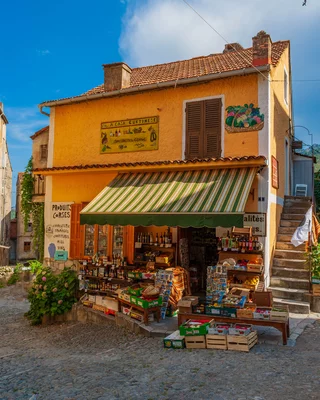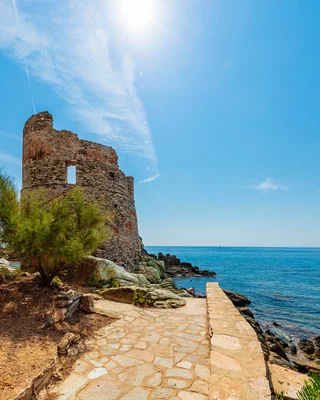Corsican knives
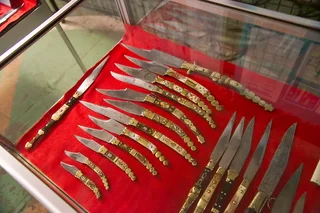
The range of Corsican knives is limitless and is the pride of the islanders. Push open the doors of the workshops of Corsican cutlery craftsmen, the artisgiani cultellaghji, who are committed to promoting their identity and heritage, and let us tell you about their love of the trade.
The history of Corsican cutlery
It began in the 2ᵉ century when Corsica became Roman. Indeed, it was the Romans who invented the folding knife, and the well-inspired Corsicans were quick to make their own. In the past, hunters and shepherds made their own knives from pieces of wood and goat horns. Over time, the island's "maestri di u focu" blacksmiths learned to skilfully process the ore and make everyday tools and weapons in the shape of the knife.
Traditional knives
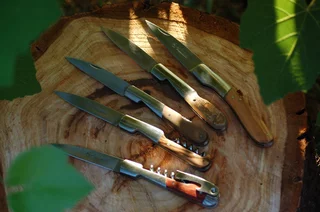
The island's cutlery industry is governed by a quality label and charter, and meets the highest standards in terms of quality, transparency and authenticity. Knife enthusiasts will be delighted.
The damascus stylus
Initially, the stylet of the 16ᵉ century was intended to pierce leather, but it was soon transformed into an official weapon by the 18ᵉ. Soldiers, hunters and hoodlums alike appropriated it, clamoring for it to be even more beautiful and to be proudly displayed. It was then made from arbutus, bone and horn handles. What does "Damascus steel" mean ? It's a technique of bending and folding steel that makes it unique and highly resistant.
The shepherd's knife
According to tradition, each young boy received this knife at the age when he was able to work in the fields. This ritual changed his status within the family, and he became an adult. This is one of the oldest knives and is called "l'amicu", the friend! It's very sturdy and easily recognizable thanks to its curved handle and strong, wide blade. Made from ram's horn, goat's horn or olive and arbutus wood, with a carbon steel, stainless steel or damascus blade, you won't be able to resist these Corsican knife creations!
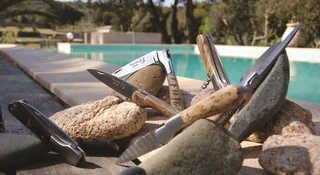
The vendetta
Once used daily as a working tool by farmers, the shape of this knife is very distinctive: pure lines and tapered forms, all elegance. This classic and emblematic Corsican knife, inspired by the stylet, is recognizable by the unhooking of its sights (the metal part that adorns the ends of the handle).
Customized creation by a cutler
A genuine Corsican knife is quite simply a knife made by a Corsican cutler, who personally oversees every stage of the manufacturing process. No subcontracting, no assembled industrial products, preferred by some cutlers to meet the demands of mass tourism. These craftsmen want to preserve and pass on "U riacquistu", the heritage inspired by the ancients, which they naturally nurture with new creations. Tradition and modernism come together in a virtuous circle where the quality of the knife takes precedence over quantity. The result is knives guaranteed for life!
Price of a genuine artisan knife
The manufacture of a knife involves a number of stages, some of which are carried out by machine, others by hand. Handles are made, blades and laminated steels are forged, and horns are fired and dried to produce unique pieces. The hardness of the cutting edge and the suppleness of the blade require long, patient work. As a signature, a punch on the blade will finish the piece (caution: do not put in the dishwasher). So you can compare it with a common copy.
It tells a story and will be your everyday companion, so don't hesitate to choose accordingly. If you're in Corsica in August, head to the foire di u focu in the village of Balagne Costa, to learn about the cutler's trade and meet with cutlery professionals, antique pieces and creations.
We are happy to lead you through our itineraries on the agritourism route Route des sensauthentiques - Strada di i sensi, to introduce you to a land of meaning and values.
Our local experts tell you all about our trips to Corsica!
How to clean a Corsican knife
When cleaning a Corsican knife, it's essential to respect the materials used to make it, in order to preserve its quality and authenticity. Handcrafted Corsican knives, renowned for their sturdiness and unique design, deserve special attention to preserve their brilliance and functionality.
- Rinse with lukewarm water : Start by gently rinsing the blade under lukewarm water. Avoid using hot water, which may affect the treatment of the steel.
- Gentle cleaning: Use mild soap and a non-abrasive sponge to clean the blade. Avoid strong detergents or metal sponges which could scratch or damage the metal.
- Dry immediately: After cleaning, dry your knife thoroughly with a soft cloth to avoid any residual moisture. Residual moisture can cause rust, especially in the Mediterranean climate of the Isle of Beauty.
- Oil the blade : Apply a thin layer of mineral oil to the blade to protect it from corrosion. This is particularly important if the knife is not used regularly.
- Handle care: If your knife's handle is made of wood or horn, it's advisable to treat it with a suitable oil to nourish the material and prevent it from drying out or cracking.
By following these simple steps, you can ensure that your handcrafted Corsican knife remains a durable and effective companion, reflecting the spirit and tradition of the Isle of Beauty. Regular maintenance not only prolongs the life of your knife, but also preserves the aesthetics and craftsmanship for which these magnificent tools are renowned.
How to recognize a real vendetta knife?
To recognize a genuine Corsican Vendetta knife, here are a few key points:
- Local manufacture : Make sure it's made in Corsica, often indicated by marks or certificates of authenticity.
- Specific design: Check that the blade is leaf-shaped, pointed and slightly curved, with a handle traditionally made of horn, wood or bone.
- Lifetime warranty: A genuine Vendetta knife often comes with a lifetime warranty, a sign of its quality and durability.
- Quality of materials : The blade should be made of high-quality stainless steel, and the handle should be sturdy and well-finished.
- Purchase from a reputable vendor: Buy from reputable artisans or vendors to avoid counterfeits.

